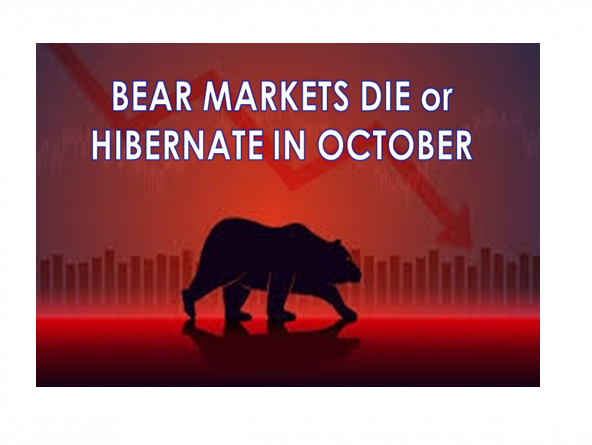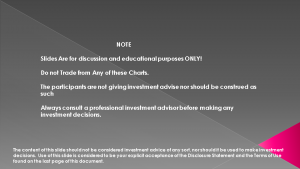IN-DEPTH: TRANSCRIPTION - LONGWave – 10-11-22 - OCTOBER – Bear Markets Die in October!
SLIDE DECK
TRANSCRIPTION
SLIDE 2
Thank you for joining me. I'm Gord Long.
A REMINDER BEFORE WE BEGIN: DO NO NOT TRADE FROM ANY OF THESE SLIDES - they are COMMENTARY for educational and discussion purposes ONLY.
Always consult a professional financial advisor before making any investment decisions.
COVER
The month of October since the infamous 1929 stock market crash has always been a tumultuous month! This October is no doubt, not going to be anything different and possibly even historic. We have experienced a 26% drop in the S&P 500 over the last 8 months. As you will see this is almost historically half way for expected Bear Markets.
Either the Bear normally ends in October with a final capitulation low; begins setting itself up for the next leg down; or dies with a traditional “W” double bottom.
In this session we will attempt to determine what the likely outcome is going to be.
AGENDA
To do that we will cover the subject areas outlined here.
SLIDE 5
Let’s start with historical comparisons to what has been unfolding so far in 2022.
SLIDE 6
We will start with the most historic market crash of all time – the October 29th, 1929 crash. The takeaways here are:
- It occurred at the end of October,
- It was proceeded by a decade of wild market speculation and returns,
- It was followed by a decade of terrible returns and the Great Depression,
- On a time scale it occurred mid-point between these two Economic extremes.
Not a pretty story but a good benchmark to start from since it is similar to our roaring markets over the last decade since the Financial Crisis and what we have recently labeled the coming Beta Drought Decade
SLIDE 7
The next major crash was the 1987 market crash. It was my personal introduction into how to lose a lot of money fast and to not trust anyone but yourself with your own money. Nobody values your hard earned money more than yourself. We see here …
- The market had been testing signal lows before it finally broke,
- The low was reached on Black Monday October 19th in the middle of Q3 earnings season,
- It had been proceeded by major turmoil in the US dollar (not too dissimilar to today),
- Then the markets were reeling from the 1985 Plaza Accord, today many have already started calling for another Plaza Accord
- We had an initial capitulation low on October 19th before completing a “W” bottom and then strongly recovering. The capitulation cleared the decks and markets regained their strength!
SLIDE 8
The next major market correction occurred in October 1990.
- Here we had an initial low in early October and the final double low in Mid October,
- Another “W” bottom that marked a firm bottom,
SLIDE 9
The next major market drop was during the bursting of the Dotcom Bubble.
- The initial trigger to this protracted Bear market occurred on October 18th,
- The market found an initial low, rebounded – then began a steady Bear Market decline,
- It was preceded by 10 high return years where valuations were massively distorted and needed to return to something representing sustainable levels,
- It subsequently took a couple of down years for this to finally be achieved.
SLIDE 10
We now get to 2008 which I am sure most can vividly recall.
- Here the low occurred on October 12th with a retest on October 28th before starting a historic climb ending in January 2022.
- The crash was a result of the use of mysterious financial instruments such as CDS’, CLO’s, SPVs, MBS’s and other Off Balance sheet accounting that had distorted and created a massive US residential mortgage debacle.
- The bottom was manufactured by over 13 Federal Reserve liquidity “Facilities”, the removal of “Market-to-Market of Bank derivatives values, the conservatorship of Fannie Mae and Freddie Mac and then sustained by the implementation of never before employed “Quantitative Easing” or simply QE.
We have all of these situations today; however they are more sophisticated, global and employ even more leverage.
The recent UK carnage unearthed another new mysterious financial instrument now being employed by Pensions plans called an “LDI” (or a Liability Driven Investment) which required the BoE to backstop the entire UK Pension system from imploding.
SLIDE 11
The final bottom I would like to highlight is October 2011.
- This was the bottom of the European Sovereign Debt Crisis,
- It was also a hard bottom where nothing was actually solved in the EU Banking System but rather was fixed by central banks effectively changing accounting rules, creating liquidity and papering over insolvency. I will call this “The Fix” or “Cheating” to temporarily keep fragile and unstable markets from imploding.
SLIDE 12
The Key observations are:
- Octobers are bad months because they often make visible problems that had been brewing for a long time. One reason is because in October we get Q3 Earnings results which tell the real story and not what sell-side Wall Street Analysts had been espousing. Suddenly the year “Hockey stick” for earnings is obviously not possible. Additionally, the coming years projections suddenly seem too optimistic based on lowered current year outlooks. The markets get a real dose of reality.
- Falling Markets stop falling because massive changes of either accounting or policies are made by central banks or governments that change the rules everyone had been playing by.”The Fix”. The powers-to-be panic and effectively cheat their way out. They do this because it is expeditious, they are expected to fix the problem and because they can without consequences (at least in the short term and before they vacate their positions and it is someone else’s problem!)
SLIDE 13
However, sometimes the powers to be simply can’t fix the problems or they just don’t know how.
You will notice we have been talking country specific crashes where the control was mostly within a single country’s powers to fix.
What happens when the problem is global? Who and how is it fixed then? This is something in our new world of globalization and Financialization we have never actually encountered.
We have been operating more recently where other impacted central banks took their lead from the US Federal Reserve.
As we shift from a Uni-Polar to Multi-Polar world of conflict this makes a tough problem extremely difficult. Especially when rapid action is required!
The question on the table today is at 269 days (as of 10/07/22), and now the longest correction we’ve seen since the March 2009 low, is this still only a "correction"...? or something much worse?
Additionally, is this a correction that can be “fixed” by a Federal Reserve Pivot?
SLIDE 14
Bear Markets normally have a different profile and duration patterns than market corrections!
Bear markets have three stages—sharp down, reflexive rebound, and a drawn-out fundamental downtrend.”
Recently Jeremy Grantham, famed investor and co-founder of GMO wrote:
“Only a few market events in an investor’s career matter; among the most important of all are Super-Bubbles. These Super-Bubbles are events unlike any others: while there are only a few in history for investors to study, they have clear features in common.
“One of those features is the bear market rally after the initial de-rating stage of the decline, but before the economy has begun to deteriorate, as it always has when Super-Bubbles burst. In all three previous cases, the market recovered over half the initial losses, luring unwary investors back just in time for the market to turn down again, only more viciously, and the economy to weaken. This summer’s rally has so far perfectly fit the pattern.”
2022 started with a sharp and swift decline which lasted well into mid-year. With extremely bearish sentiment, it was no surprise that July and August saw an oversold bounce that retraced a portion of that decline.
However, with that retracement now behind us, the concern is that the third phase of the Super-bubble has yet to commence. That third phase is a slower and more grinding decline that coincides with deteriorating fundamentals.
SLIDE 15
History suggests that the Trifecta of Fundamentals of:
- The rapid rise in the dollar,
- Rising Interest rates and
- Rising Oil prices
… over the past couple of years represent a uniquely bearish occurrence that will likely have a very negative effect on earnings over the next year or so. Long-term technical’s, notably momentum, appear to confirm this analysis.
And bearish fundamentals paired with bearish technical’s may simply be an effective way of defining a bear market (better at least than the arbitrary 20% rule).
Given that we are now in a bear market (however you choose to define it), history suggests we may only be about halfway through the process. Previous downturns driven by the bearish Trifecta were both more prolonged and more significant in terms of price decline than what we have seen in the stock market so far. Of course, history doesn’t repeat itself but it often rhymes; so while the current bear market is unlikely to follow the pattern perfectly, the price analog may be as good a map for the road ahead as any you’ll find.
SLIDE 16
I like this chart of Earnings Breadth going back prior to the 2008 Financial Crisis. We had an extended period of anxiety, a downward trending market and weakening earnings breadth which culminated in a major thrust down as capitulation took hold.
We appear to have a similar set-up today which would retrace the entire market movement associated with Quantitative Easing!
SLIDE 17
I have outlined the potential for an Elliott Wave Double Combo or Zigzag pattern formation to potentially be underway. It is a pattern that appears when major changes are underway in the market that require through time, price and volatility to work major change and sentiment adjustments into the markets.
Though this schematic is representing a rather mild trend, the trends can be steeper both to the downside and upside in the “W” and “Y” legs while the “X” consolidation leg is flat.
SLIDE 18
This is what I believe we are likely presently in. We have completed the “W” leg since the market top and are now in the “X” corrective leg.
Though I show the “X” leg as potentially complete there is a strong likelihood the “X” leg may be an extended 5 Wave continuation channel. We are presently in the midst of a major test.
We may be putting in a Double Bottom and the current bear Market is over OR we are about to break done in leg “Y-1200” OR we compete the continuation triangle through year end.
Only the markets know for sure though we have a lot more data to yet overlay on what is at play as part of this market test.
SLIDE 19
The fundamentals currently support a near term break down but followed with an intermediate term rise and longer term drop as part of a larger bear market out into 2025.
SLIDE 20
I show that possibility here with the current Double Combo being the incomplete initial white leg down to very close to our 3270 -- shown here as 3150.
SLIDE 21
The current Double Combo pattern would deliver the final drop to the longer term dotted red parabolic rise. We would then rise higher to possibly complete a double top in 2025 before heading down for the rest of the decade in what I have referred to in other writings as the Beta Drought Decade.
This would be a period likely to eventually be labeled the Great Stagflation and marked by plus 5% annual inflation era.
SLIDE 22
The OIS risk measure correlation is suggesting our current test will fail to the downside.
SLIDE 23
Our long term S&P 500, which we have shown since early 2021, is also suggesting we are potentially ready to break to the downside with a completed smaller Right Shoulder and broken Neckline in as we approach the neckline of a larger Head and Shoulders with its Right Shoulder already in.
SLIDE 24
Let’s shift gears a little and consider the current tightening actions of the global central banks.
SLIDE 25
The S&P 500 continues to mirror the cumulative tightening of central bank balance sheets. This tightening significantly increased by the US Federal Reserve in September and is about to really kick into high gear – IF THE FED DOESN’T SUDDENLY PVIOT when something serious suddenly breaks or the noise of recession becomes just too loud for them.
SLIDE 26
We need to be reminded that rising rates are revealing market fragilities but cracks aren’t just in the UK. Also we highly likely won’t see a U-turn from central banks until we get a recession confirmation, or something breaks; but we will only get band-aids and talk until then.
SLIDE 27
The last 3 times that the US financial conditions have been this 'tight', central bankers folded like a cheap suit: early 2016, global central bank balance sheets started to expand once again rapidly; late 2018, Powell rapidly about-faced on The Fed's rate-hike cycle as stocks puked; and March 2020 when every policymaker in the world unleashed money-printing hell on a globally locked down citizenry...
SLIDE 28
The Financial Conditions Index looks like a trading range. A trading range which is trying to take the panic out of the market before going lower in a “controlled and sustained manner”! The Central Bankers don’t want a panic, overdone capitulation that takes the global financial system with it!
SLIDE 29
This is a trading range that out modified Double Combo consolidation triangle is signaling.
SLIDE 30
There are lots of surprising outside influencers now taking highly visible positions.
I don’t ever recall the UN taking such a strong public position as they did last week?
The World Trade Organization published a new report that outlines a sharp slowdown in world trade is expected for next year under the weight of skyrocketing energy prices, soaring interest rates, and war-related disruptions, with increasing risks of a global recession.
WTO economists expect world trade to "lose momentum in the second half of 2022 and remain subdued in 2023 as multiple shocks weigh on the global economy."
The WTO's downgrades to global trade align with new IMF and OECD projections. This is a drastic change and a considerable deceleration from last year's 9.7% growth in international trade. Consumers, fueled by stimmy checks and ultra-low rates by central banks during Covid, are dialing back on spending as the hangover phase is underway.
I quote:
"We're looking at a situation in which a global slowdown is going to squeeze households even more, squeeze businesses and we may be edging into a recession.
"It's looking quite grim -- a little more grim than we had thought," WTO Director-General Ngozi Okonjo-Iweala said in an interview with Bloomberg Television.
SLIDE 31
The pandemic boom trade has ended as the global economy faces a multipronged crisis. We noted the reversal in the "shortage of everything" bullwhip effect has led to container lines on major shipping routes canceling sailings as US importers do not need to increase purchases of foreign goods because of rising domestic inventory as consumers are on strike due to negative real wage growth, low savings, and maxed out credit cards amid worst inflation in decades.
Last month, FedEx Corp.'s CEO Raj Subramaniam delivered a chilling message while speaking with CNBC's Mad Money with Jim Crammer: The global economy is "going into a worldwide recession.“
More evidence of the world stumbling into trouble is JP Morgan's Global PMIs now sub 50, which means contraction.
WTO's latest report is a reminder that 2023 economic outlooks for the world are quickly darkening as excess tightening by central banks could spark an even more significant downturn.
The question is whether we will actually be able to put a global fix in like we have typically done in past market crisis?
SLIDE 32
As you are no doubt well aware we watch credit markets and real rates very closely to give us early warnings of the degree of severity our current problems are realistically facing.
SLIDE 33
We don’t ever recall seeing real US rates change so dramatically in such as short period of time. It is historic and extremely worrisome. We have went from -1.2% to + 1.64 % in one year.
SLIDE 34
Rising Real Rates have correlated closely with a similarly spiking US$ and falling major G7 currencies, rising US Treasury Yields and falling global Equities.
The correlation is indisputable and is the source of the major global institutions worry.
SLIDE 35
If something was to break it will take the global economy with it! Where will the break come from? We can now expect to see retail prices at the pump to start creeping up and to explode after the US mid-term elections!
SLIDE 36
We have rapidly rising Geo-Political tensions which are dramatically complicating global energy supplies.
The only ways to reduce the price of oil are to produce more of it or consume less of it. It’s hard to produce more when the President and many of his powerful oligarch buddies are aggressively intervening to ensure that it’s difficult to expand or finance production. Meanwhile, no one wants to invest when there are constant threats of excess profits taxes, carbon taxes, expropriation and price caps. Since the obvious solution has been made so impossible, the Fed has been forced to embark on a plan to reduce global energy consumption.
How do you reduce oil consumption?? Well, it seems that their plan is to create a global depression.So, after a decade of paying lip-service to “inclusive economics” and “closing the wealth gap,” the Fed has been forced to pivot and destroy the finances of the world’s poor, in the hopes that they’ll consume less oil. For the past half-year, this plan has unfolded with the usual crescendo of mini-temblors as global growth screeches to a halt and over-leveraged institutions find themselves on the wrong side of asset depreciation. The Fed is now well on its way towards creating an economic crisis that will reduce global energy consumption—consequences be damned.
Naturally, most global citizens do not want a lower standard of living so that US consumers can continue their orgy of excess.In fact, many global citizens owe their current standard of living due to elevated energy prices. Hence, after watching Biden liquidate the Strategic Petroleum Reserve in order to improve his polling numbers, while watching the Fed directly target their standard of living and that of their customers, OPEC has had enough. They’re going to do something about the Fed and its war on oil. OPEC has finally launched a counterattack. Last month, they agreed to cut output by 100,000 bbl/d. It was meant as a warning that went unheeded. Tomorrow, they’re going to Blitzkrieg the Fed.
No one knows how big the cuts will be and frankly, it doesn’t matter how large they are. Instead, the message is clear—the Fed can crash global GDP in their fight against oil, but OPEC wields a much larger stick and will cut production even faster. In fact, OPEC will DO WHATEVER IT TAKES if the Fed continues on this path. OPEC has drawn a line under the price of oil and told the Fed that it’s wasting its time. OPEC controls the price of oil and oil is the world’s Central Banker, not the Fed.
Last Monday morning, the market heard that message loud and clear. The Fed is trapped, oil is going higher, and the Fed is powerless to contain it. Why would the Fed continue trying to blow up the world’s financial markets if oil will not bend to their will??
OPEC’s counterattack has changed the calculus and the Fed is now on the backfoot. If you can’t win at something, why try?? Especially if you’re going to leave casualties all over the financial markets.
SLIDE 37
Global supply and demand are roughly in balance today. Add in 1.5 million bbl/d of global SPR releases that will end soon, add in 2 million bbl/d of reduced demand from Chinese covid lock-downs that appear to be ending, add in 1 million bbl/d that Russian oil will decline by in 2023 (at a minimum), add in the 1 million bbl/d that global demand seems to expand by each year and assume that global supply somehow grows by 1 million bbl/d (though it isn’t clear where that growth would be coming from) and you have a 4.5 million bbl/d swing in 2023. Now add in whatever OPEC chooses and you realize that there’s an imminent and exponential crisis for the consumers of oil.
Of course, the Fed could destroy enough global GDP to erase 4.5 million bbl/d of global oil demand and stop the price from exploding, but OPEC just told them that they’ll DO WHATEVER IT TAKES. Do you think the Fed continues its war on GDP when they now know they’ll fail to contain the price of oil??
SLIDE 38
Needless to say, as this increasingly hot war between OPEC+ and the West (i.e., Fed) escalates, the total amount of oil available to the West will go down, not up, forcing the Fed to hike even more to offset the decline in supply with even less demand (and perhaps even forcing to US to turn "kinetic" in delivering Democracy to Ryadh), a cycle which will go on until the Fed finally breaks something in the hyperfinancialized US economy in which financial assets were 630% of GDP at least check...
... or in other words, OPEC+ doesn't have to defeat the entire west: just its weakest financial institution whose collapse will drag down everything else. At that point global commodity producers, including Russia, will have effectively defeated the world's former superpower.
SLIDE 39
In 2023, energy will be the only thing that matters to investors. Everything else, including the Fed will be a side-show. Who’s ready for the insanity wave??
We just had a half-year pause in my oil thesis, now it’s potentially about to resume with vigor!
SLIDE 40
Gold and Silver have recently risen dramatically from their major lows with recent geo-political tensions. This action is not too dis-similar to what we saw earlier this year with the outbreak of the Ukraine conflict.
SLIDE 41
The 5Y Treasury Yield correlation says we are highly likely to see a convergence. We have consistently seen the bond market to be correct and the equity markets to follow.
SLIDE 42
The question is; what could we see happening with valuations in this environment and why?
SLIDE 43
Since 2001 the US S&P 500 alone has employed ~$10 Trillion of corporate capital to buy back its shares with no other real purpose than other to drive up stock prices. Prices that have now started to come down as nearly $29T in wealth has been extracted from the equity and bond markets since the beginning of the year!
I put the bond market loses in that number because a substantial amount of the money used for buying back corporate shares was borrowed. The primary way of doing that was issuing new corporate bonds.
Effectively they swapped future debt obligations for equity prices today. Those who sold the corporate equities today have had the opportunity to exit before the debt has to be paid! They have fled the party as market prices became unsustainable, since knowingly debt payments would eventually depress earnings.
This cannot continue for fundamental reasons but as we leave the “black out period this week it doesn’t mean near term the buyback momentum doesn’t continue. There is evidence this will.
SLIDE 44
Additionally, corporations have been using borrowed money to pay dividends. These dividends have paying more than treasuries and bank rates thereby making stocks attractive to yield starved investors and institutions.
This coupled with stock buybacks has been a giddy cocktail for the markets and though both will soon begin shrinking there is also evidence from preliminary Q3 earnings that this is not about to end just yet!
SLIDE 45
There is a lot of evidence that it only when a recession actually is seen to be occurring that the redemption cycle kicks in. This is when markets really start heading lower and force capitulation as it steadily gets worse!
SLIDE 46
Global outflows and shifts to cash are underway but are still in the early stages.
SLIDE 47
CASH IS STEADILY BECOMING KING!
Return on money is a strong force! Return of Money is an even stronger force.
SLIDE 48
We are generally seeing reticence to add risk. Hedge Fund flows have shifted towards de-grossing (part of this is due to short covering, but longs have also starting being sold).
Net flows have been slightly skewed negatively as well.
Hedge Fund buyers remain positioned and cautious.
SLIDE 49
It is looking more and more like the 10Y UST Yield needs to spike above 4% for a precipitous sell-off to be triggered. This may happen quickly or take more time to buildup explosive pressure.
SLIDE 50
The S&P 500 P/E multiple compressed by 27% from 21x in January to 16x before the latest bounce. And maybe the E is not even that wrong...This simple search for support suggests a minimum 3% further spike lower in PE’s. When we add a drop in Q3 “E” earnings we could easily see our 3270 projection or worse before finding a short to intermediate bottom.
SLIDE 52
I have intentionally left earnings to the end. We are now entering the Q3 earnings season and they will be the big tell!
The market’s actual interpretation of the earnings will be what you need to watch for. The public announcements hide a lot of what is actually going on.
SLIDE 53
According to a just released Fed paper entitled: “The coming long-run slowdown in corporate profit growth and stock returns”
I quote from the report:
'The reduction in interest and tax expenses is responsible for a full one-third of all profit growth over the prior two-decade period. That boost to corporate profits is unlikely to continue, indicating notably lower stock returns in the future.'
When profits and growth fall, normally cash flow falls off. This means:
A high probability fall-off in the $10T rate of stock buybacks,
Reduced cash and borrowing capabilities for inflating dividend payouts
Instead of reduced interest expense we are now seeing rising interest expense,
Instead of reduced tax expense we now seeing rising tax expense with the US government’s new 15% Minimum Corporate Tax being implemented as part of the just signed “Inflation Reduction Act”.
We can expect the Beta Drought to be a very real eventuality!
SLIDE 54
As demand weakens domestically and globally, investors should not expect corporate profits to remain near record levels. As shown, the current gap between asset prices and corporate profits is at the greatest deviation on record.
“Profit margins are probably the most mean-reverting series in finance, and if profit margins do not mean-revert, then something has gone badly wrong with capitalism. If high profits do not attract competition, there is something wrong with the system, and it is not functioning properly.” – Jeremy Grantham
SLIDE 55
Q3 Earnings are just beginning to come out this week. The best we know for sure comes from Factset dated Friday October 7th.
KEY METRICS
- Earnings Growth: For Q3 2022, the estimated earnings growth rate for the S&P 500 is 2.4%. If 2.4% is the actual growth rate for the quarter, it will mark the lowest earnings growth rate reported by the index since Q3 2020 (-5.7%).
- Earnings Revisions: On June 30, the estimated earnings growth rate for Q3 2022 was 9.9%. Ten sectors are expected to report lower earnings today (compared to June 30) due to downward revisions to EPS estimates.
- Earnings Guidance: For Q3 2022, 65 S&P 500 companies have issued negative EPS guidance and 41 S&P 500 companies have issued positive EPS guidance.
SLIDE 56
- Valuation: The forward 12-month P/E ratio for the S&P 500 is 15.8. This P/E ratio is below the 5-year average (18.5) and below the 10-year average (17.1).
- Earnings Scorecard: For Q3 2022 (with 20 S&P 500 companies reporting actual results), 14 S&P 500 companies have reported a positive EPS surprise and 13 S&P 500 companies have reported a positive revenue surprise.
SLIDE 57
As we wrap up here, what are the conclusions?
SLIDE 58
One, we have reached the point at which historical outcomes have started to deviate a lot! We could go either way from here. We are at a critical test point.
SLIDE 59
Two, the European Credit Default Swaps are now at Pandemic highs. My bet is that of all the possibilities of what will break is somewhere in the EU Banking System. It may not be Credit Suisse but is likely to be the trigger of an “Unintended Consequence” and ‘Third Party Failure” that delivers the next downward shock!
SLIDE 60
Third, we need to remember how the 26% decline over the past 8 month compares to other bear markets? Shown here’s a table going back to 1929.
What it shows is high variability from one bear market to the next, with an average/median decline of 36%/29% over an average/median duration of 14/12 months.
We are highly likely only half way through this downward trend!
SLIDE 61
As I always remind you in these videos, remember politicians and Central Banks will print the money to solve any and all problems, until such time as no one will take the money or it is of no value.
That day is still in the future so take advantage of the opportunities as they currently exist.
Investing is always easier when you know with relative certainty how the powers to be will react. Your chances of success go up dramatically.
The powers to be are now effectively trapped by policies of fiat currencies, unsound money, political polarization and global policy paralysis.
SLIDE 62
I would like take a moment as a reminder:
DO NO NOT TRADE FROM ANY OF THESE SLIDES - they are for educational and discussion purposes ONLY.
As negative as these comments often are, there has seldom been a better time for investing. However, it requires careful analysis and not following what have traditionally been the true and tried approaches.
Do your reading and make sure you have a knowledgeable and well informed financial advisor.
So until we talk again, may 2022 turn out to be an outstanding investment year for you and your family.
Thank you for listening.






